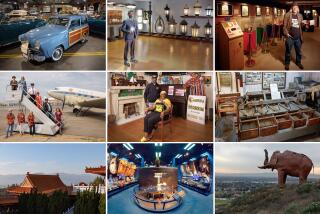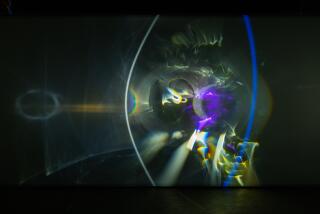DIRECTOR RICHARD KOSHALEK IS MOCA’S MAN ON THE MOVE
- Share via
Richard Koshalek, Museum of Contemporary Art director, was huddled at the elevator with a foundation executive, reporter and photographer. His assistant, Alma Ruiz, came running down the hall: “Did you tell (art dealer) Irving Blum I’d give him a tour of the new building?” she asked Koshalek frantically. “No,” he responded, hustling his group into the elevator, “I told him I’d give him a tour.”
Nobody wanted to wait for last week’s black-tie previews, much less the museum’s official opening Wednesday. Museum directors, collectors, dealers and journalists were descending on architect Arata Isozaki’s $23-million Bunker Hill showplace and on Koshalek from as far away as Israel and Switzerland. Phone calls came pouring through Koshalek’s office, while assorted celebrity visitors were wandering all over the building.
Koshalek and company were essentially reaping the promotional harvests they had long sown. Even before the museum owned a single painting, much less a wall to hang it on, MOCA had been the talk of the international art circuit and plenty of people wanted to see-- sans crowds--what all the shouting was about.
Consider the day before Thanksgiving. Koshalek was in perpetual motion, stacking one personalized gallery tour after another. When a colleague was a few minutes late to scoop up Koshalek for a lunch meeting with banker Carl Hartnack, a MOCA trustee, the director dropped his bag of box lunches on the Grand Avenue sidewalk and rushed off to make one more phone call.
Koshalek, 45, was running on reserve batteries. During the drive down the hill to MOCA’s 3-year-old Temporary Contemporary in Little Tokyo, he interrupted his own thoughts again and again, at one point to comment on the MOCA banners that would soon blanket downtown, at another to identify First Street pedestrian David Warrilow, a performer in “Zangezi,” the theater piece currently on stage at MOCA.
So immersed was Koshalek in MOCA’s doings, so tuned to the MOCA channel that ran through his head, that he could already visualize what wasn’t yet there. In front of the Temporary Contemporary, for instance, an excited Koshalek called everyone’s attention to artist Robert Irwin’s commissioned installation, “Central Avenue Meridian.” “There it is,” he shouted. “Where?” asked Hartnack. “There,” Koshalek responded, pointing to a hole in the ground. (The now-finished Irwin piece on Central Avenue features bamboo trees against a tall sea-foam green chain-link fence that occasionally emits water mist.)
Back at the new building a while later, Koshalek shepherded W.M. Keck Foundation program officer Ann Gralnek and a growing entourage of visitors through the galleries. Artists, curators and others were completing last-minute installations, and people flowed from room to room, talking about the art, visiting with artists. “It’s a party,” commented a jovial Dan Flavin, supervising final installation of his neon artworks. “You shouldn’t get too serious.”
On to December and last week’s rash of press tours and parties. Dozens of film crews and print journalists swarmed through the galleries, and nearly everyone wanted to either photograph or talk with Koshalek, the most prominent spokesman of the 7-year-old institution.
Take the dedication last Monday morning, for instance. After the speeches and ribbon-cutting, after hundreds of colored balloons were launched, Koshalek invited the 150 or so guests downstairs to see the “Individuals” exhibition.
Koshalek, however, never got there. Instead, the press got him. Conservatively dressed in grey-flannel pinstripes, his eyeglasses held carefully in his hands during the filmed interviews, Koshalek moved less than 10 feet during the next hour or so. First a KNBC Channel 4 crew had its turn, then KCBS Channel 2. KCET Channel 28 got a few minutes; KCOP Channel 13 stood by.
Three print journalists, one from Canada, each had a few minutes before the director was swept away to tape a one-hour future segment of KUSC-FM’s “Backstage at Royce.” (By Tuesday evening, in fact, he even lost his voice temporarily from all the radio and TV interviewing.)
Even daughter Anne, 12, had her camera on Koshalek, snapping an occasional photo during the dedication events. No matter that she skipped school to be there. In her sweatshirt from the soon-to-be-opened MOCA bookstore, her camera in hand, she patiently waited for her father to take her to lunch.
Some break. Koshalek’s two executive assistants were waiting on the museum’s front steps to grab him on his return and send him careening off for more press meetings. Both women had lunched on the steps to make certain they’d catch him, Ruiz said, rushing off herself once that duty had been completed.
Koshalek was also available to visiting colleagues. Several out-of-town museum directors had come by for private tours, while 35 museum directors from Japan and Sweden as well as New York and Los Angeles attended a lunch in MOCA’s honor at the J. Paul Getty Museum on Tuesday. (When Belgian museum executive Flor Bex told Koshalek that his cab had trouble finding MOCA, Koshalek mused aloud about bringing cabdrivers in for drinks and orientation, perhaps sending them maps.)
Not that the pace was unfamiliar. Or, as Koshalek put it: “One museum director who is very much involved in contemporary art said that what MOCA has done is telescope into three to five years what most museums would have taken a much longer period of time to accomplish: completing two buildings, both involving the work of important, innovative architects, building the core of the collection and presenting a program of exhibitions and performing arts events over the last three years.”
Even Koshalek seemed impressed as he ticked off recent history. The former director of both the Hudson River Museum in Westchester County, New York, and Texas’ Fort Worth Art Museum first came here in 1980 as the museum’s chief curator and its deputy director--to director Pontus Hulten, who resigned in 1982--and conceded that much of what has happened to him at MOCA “came as a surprise.”
Not all the surprises have been pleasant ones either. But despite disputes over the building’s architecture, the departure of Hulten and, more recently, public concern by trustee Count Giuseppe Panza di Biumo that the board has contemplated sale of part of his collection to pay for the rest of it, Koshalek said: “It’s been a good experience to be involved in the problems that confront an institution like MOCA and to also be involved with the people that helped make it happen.”
Flat statements like that aren’t usually Koshalek’s style, but he was clearly wearying of telling MOCA’s tale so many times to so many people.
Better to talk about the future, about how he’d like people to discuss MOCA in 10 years: “I’d like them to say that MOCA did stress quality, that MOCA was involved in the City of Los Angeles in a meaningful way, that the museum did provide access to the work of the most creative people working today, that it had respect for its responsibility to be involved in research, scholarship and education, and that it continued to grow and to improve.
“The press, artists, critics, collectors and general public all have great expectations for MOCA. MOCA is going to try like hell to meet those expectations.”
More to Read
The biggest entertainment stories
Get our big stories about Hollywood, film, television, music, arts, culture and more right in your inbox as soon as they publish.
You may occasionally receive promotional content from the Los Angeles Times.










